Examining the Moral Dimensions of Euthanasia: Philosophical Essay
VerifiedAdded on 2020/04/21
|7
|1872
|122
Essay
AI Summary
This essay delves into the complex philosophical debate surrounding euthanasia, exploring arguments for and against its moral permissibility. It begins by defining euthanasia as the deliberate ending of a person's life to alleviate suffering and acknowledges its varying legal status across nations. The central argument posits that euthanasia can be morally justified when respecting a person's wishes to end unbearable pain and suffering, especially when their condition offers no prospect of improvement. The essay addresses counterarguments, such as the claim that suicide is inherently irrational and that euthanasia might be mistaken, by emphasizing the importance of rational decision-making, informed consent, and thorough medical evaluation. It distinguishes euthanasia from murder, framing it as an act of mercy focused on allowing a person to die with dignity rather than actively killing them. The essay concludes that euthanasia is morally permissible under specific, well-defined circumstances where all other options have been exhausted and the individual's suffering is irremediable.
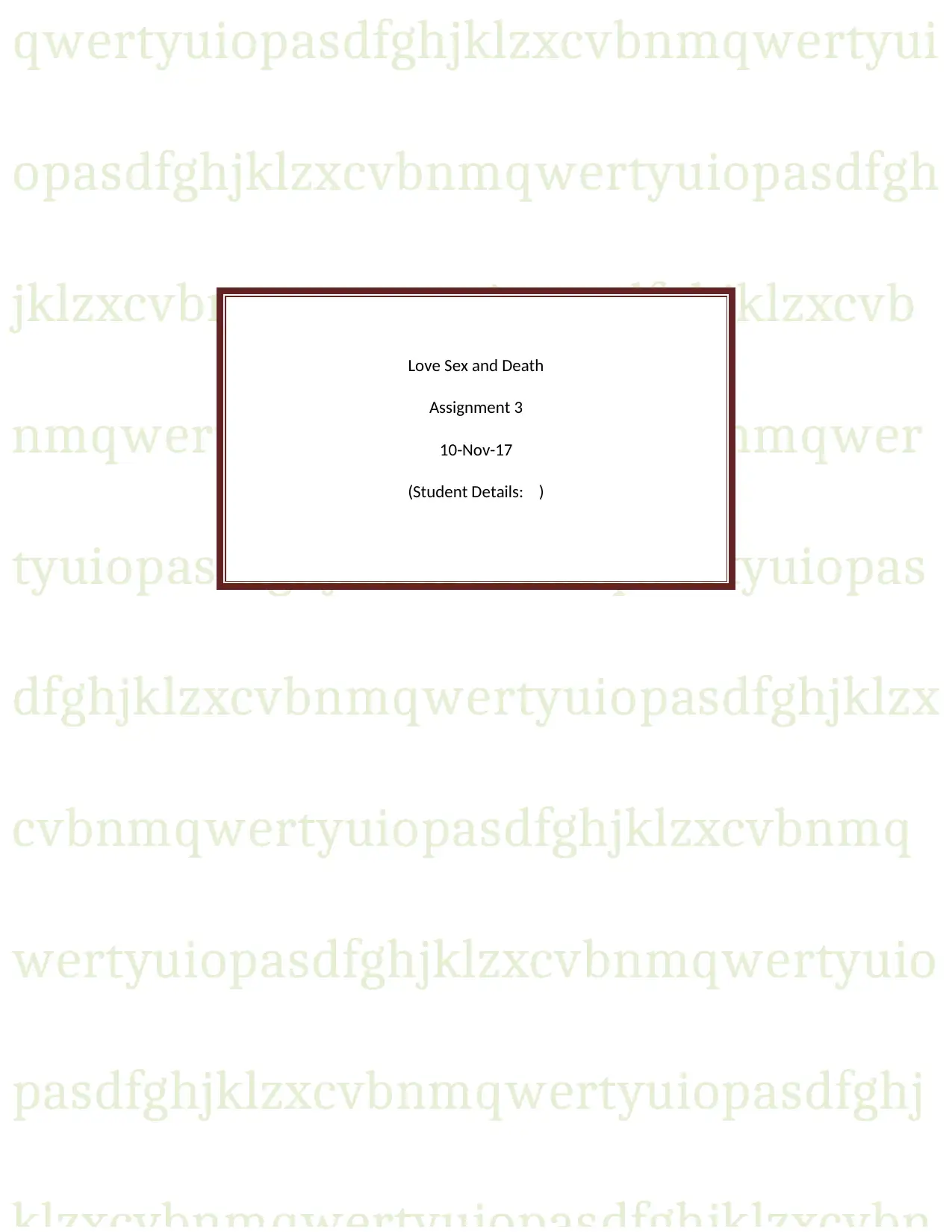
qwertyuiopasdfghjklzxcvbnmqwertyui
opasdfghjklzxcvbnmqwertyuiopasdfgh
jklzxcvbnmqwertyuiopasdfghjklzxcvb
nmqwertyuiopasdfghjklzxcvbnmqwer
tyuiopasdfghjklzxcvbnmqwertyuiopas
dfghjklzxcvbnmqwertyuiopasdfghjklzx
cvbnmqwertyuiopasdfghjklzxcvbnmq
wertyuiopasdfghjklzxcvbnmqwertyuio
pasdfghjklzxcvbnmqwertyuiopasdfghj
Love Sex and Death
Assignment 3
10-Nov-17
(Student Details: )
opasdfghjklzxcvbnmqwertyuiopasdfgh
jklzxcvbnmqwertyuiopasdfghjklzxcvb
nmqwertyuiopasdfghjklzxcvbnmqwer
tyuiopasdfghjklzxcvbnmqwertyuiopas
dfghjklzxcvbnmqwertyuiopasdfghjklzx
cvbnmqwertyuiopasdfghjklzxcvbnmq
wertyuiopasdfghjklzxcvbnmqwertyuio
pasdfghjklzxcvbnmqwertyuiopasdfghj
Love Sex and Death
Assignment 3
10-Nov-17
(Student Details: )
Paraphrase This Document
Need a fresh take? Get an instant paraphrase of this document with our AI Paraphraser
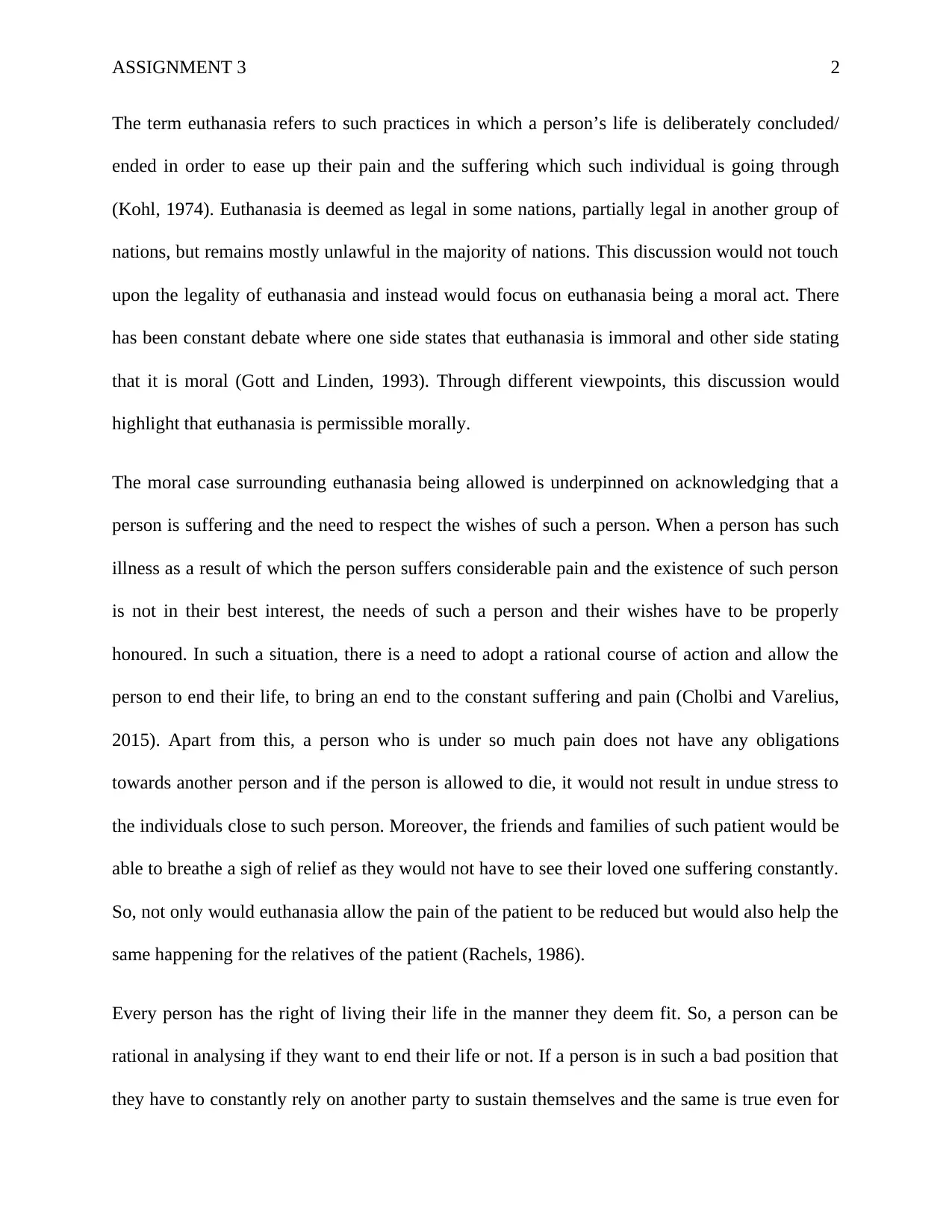
ASSIGNMENT 3 2
The term euthanasia refers to such practices in which a person’s life is deliberately concluded/
ended in order to ease up their pain and the suffering which such individual is going through
(Kohl, 1974). Euthanasia is deemed as legal in some nations, partially legal in another group of
nations, but remains mostly unlawful in the majority of nations. This discussion would not touch
upon the legality of euthanasia and instead would focus on euthanasia being a moral act. There
has been constant debate where one side states that euthanasia is immoral and other side stating
that it is moral (Gott and Linden, 1993). Through different viewpoints, this discussion would
highlight that euthanasia is permissible morally.
The moral case surrounding euthanasia being allowed is underpinned on acknowledging that a
person is suffering and the need to respect the wishes of such a person. When a person has such
illness as a result of which the person suffers considerable pain and the existence of such person
is not in their best interest, the needs of such a person and their wishes have to be properly
honoured. In such a situation, there is a need to adopt a rational course of action and allow the
person to end their life, to bring an end to the constant suffering and pain (Cholbi and Varelius,
2015). Apart from this, a person who is under so much pain does not have any obligations
towards another person and if the person is allowed to die, it would not result in undue stress to
the individuals close to such person. Moreover, the friends and families of such patient would be
able to breathe a sigh of relief as they would not have to see their loved one suffering constantly.
So, not only would euthanasia allow the pain of the patient to be reduced but would also help the
same happening for the relatives of the patient (Rachels, 1986).
Every person has the right of living their life in the manner they deem fit. So, a person can be
rational in analysing if they want to end their life or not. If a person is in such a bad position that
they have to constantly rely on another party to sustain themselves and the same is true even for
The term euthanasia refers to such practices in which a person’s life is deliberately concluded/
ended in order to ease up their pain and the suffering which such individual is going through
(Kohl, 1974). Euthanasia is deemed as legal in some nations, partially legal in another group of
nations, but remains mostly unlawful in the majority of nations. This discussion would not touch
upon the legality of euthanasia and instead would focus on euthanasia being a moral act. There
has been constant debate where one side states that euthanasia is immoral and other side stating
that it is moral (Gott and Linden, 1993). Through different viewpoints, this discussion would
highlight that euthanasia is permissible morally.
The moral case surrounding euthanasia being allowed is underpinned on acknowledging that a
person is suffering and the need to respect the wishes of such a person. When a person has such
illness as a result of which the person suffers considerable pain and the existence of such person
is not in their best interest, the needs of such a person and their wishes have to be properly
honoured. In such a situation, there is a need to adopt a rational course of action and allow the
person to end their life, to bring an end to the constant suffering and pain (Cholbi and Varelius,
2015). Apart from this, a person who is under so much pain does not have any obligations
towards another person and if the person is allowed to die, it would not result in undue stress to
the individuals close to such person. Moreover, the friends and families of such patient would be
able to breathe a sigh of relief as they would not have to see their loved one suffering constantly.
So, not only would euthanasia allow the pain of the patient to be reduced but would also help the
same happening for the relatives of the patient (Rachels, 1986).
Every person has the right of living their life in the manner they deem fit. So, a person can be
rational in analysing if they want to end their life or not. If a person is in such a bad position that
they have to constantly rely on another party to sustain themselves and the same is true even for
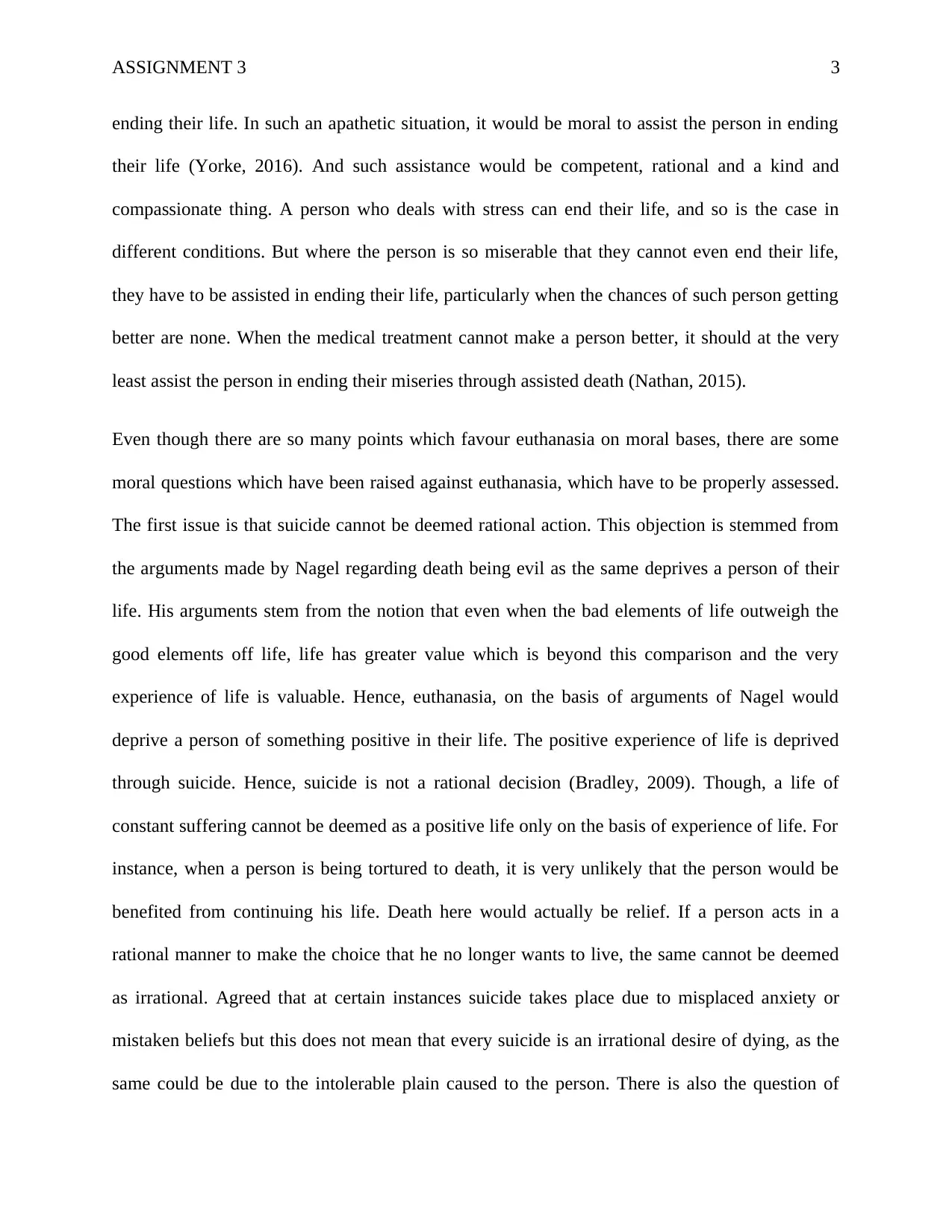
ASSIGNMENT 3 3
ending their life. In such an apathetic situation, it would be moral to assist the person in ending
their life (Yorke, 2016). And such assistance would be competent, rational and a kind and
compassionate thing. A person who deals with stress can end their life, and so is the case in
different conditions. But where the person is so miserable that they cannot even end their life,
they have to be assisted in ending their life, particularly when the chances of such person getting
better are none. When the medical treatment cannot make a person better, it should at the very
least assist the person in ending their miseries through assisted death (Nathan, 2015).
Even though there are so many points which favour euthanasia on moral bases, there are some
moral questions which have been raised against euthanasia, which have to be properly assessed.
The first issue is that suicide cannot be deemed rational action. This objection is stemmed from
the arguments made by Nagel regarding death being evil as the same deprives a person of their
life. His arguments stem from the notion that even when the bad elements of life outweigh the
good elements off life, life has greater value which is beyond this comparison and the very
experience of life is valuable. Hence, euthanasia, on the basis of arguments of Nagel would
deprive a person of something positive in their life. The positive experience of life is deprived
through suicide. Hence, suicide is not a rational decision (Bradley, 2009). Though, a life of
constant suffering cannot be deemed as a positive life only on the basis of experience of life. For
instance, when a person is being tortured to death, it is very unlikely that the person would be
benefited from continuing his life. Death here would actually be relief. If a person acts in a
rational manner to make the choice that he no longer wants to live, the same cannot be deemed
as irrational. Agreed that at certain instances suicide takes place due to misplaced anxiety or
mistaken beliefs but this does not mean that every suicide is an irrational desire of dying, as the
same could be due to the intolerable plain caused to the person. There is also the question of
ending their life. In such an apathetic situation, it would be moral to assist the person in ending
their life (Yorke, 2016). And such assistance would be competent, rational and a kind and
compassionate thing. A person who deals with stress can end their life, and so is the case in
different conditions. But where the person is so miserable that they cannot even end their life,
they have to be assisted in ending their life, particularly when the chances of such person getting
better are none. When the medical treatment cannot make a person better, it should at the very
least assist the person in ending their miseries through assisted death (Nathan, 2015).
Even though there are so many points which favour euthanasia on moral bases, there are some
moral questions which have been raised against euthanasia, which have to be properly assessed.
The first issue is that suicide cannot be deemed rational action. This objection is stemmed from
the arguments made by Nagel regarding death being evil as the same deprives a person of their
life. His arguments stem from the notion that even when the bad elements of life outweigh the
good elements off life, life has greater value which is beyond this comparison and the very
experience of life is valuable. Hence, euthanasia, on the basis of arguments of Nagel would
deprive a person of something positive in their life. The positive experience of life is deprived
through suicide. Hence, suicide is not a rational decision (Bradley, 2009). Though, a life of
constant suffering cannot be deemed as a positive life only on the basis of experience of life. For
instance, when a person is being tortured to death, it is very unlikely that the person would be
benefited from continuing his life. Death here would actually be relief. If a person acts in a
rational manner to make the choice that he no longer wants to live, the same cannot be deemed
as irrational. Agreed that at certain instances suicide takes place due to misplaced anxiety or
mistaken beliefs but this does not mean that every suicide is an irrational desire of dying, as the
same could be due to the intolerable plain caused to the person. There is also the question of
⊘ This is a preview!⊘
Do you want full access?
Subscribe today to unlock all pages.

Trusted by 1+ million students worldwide
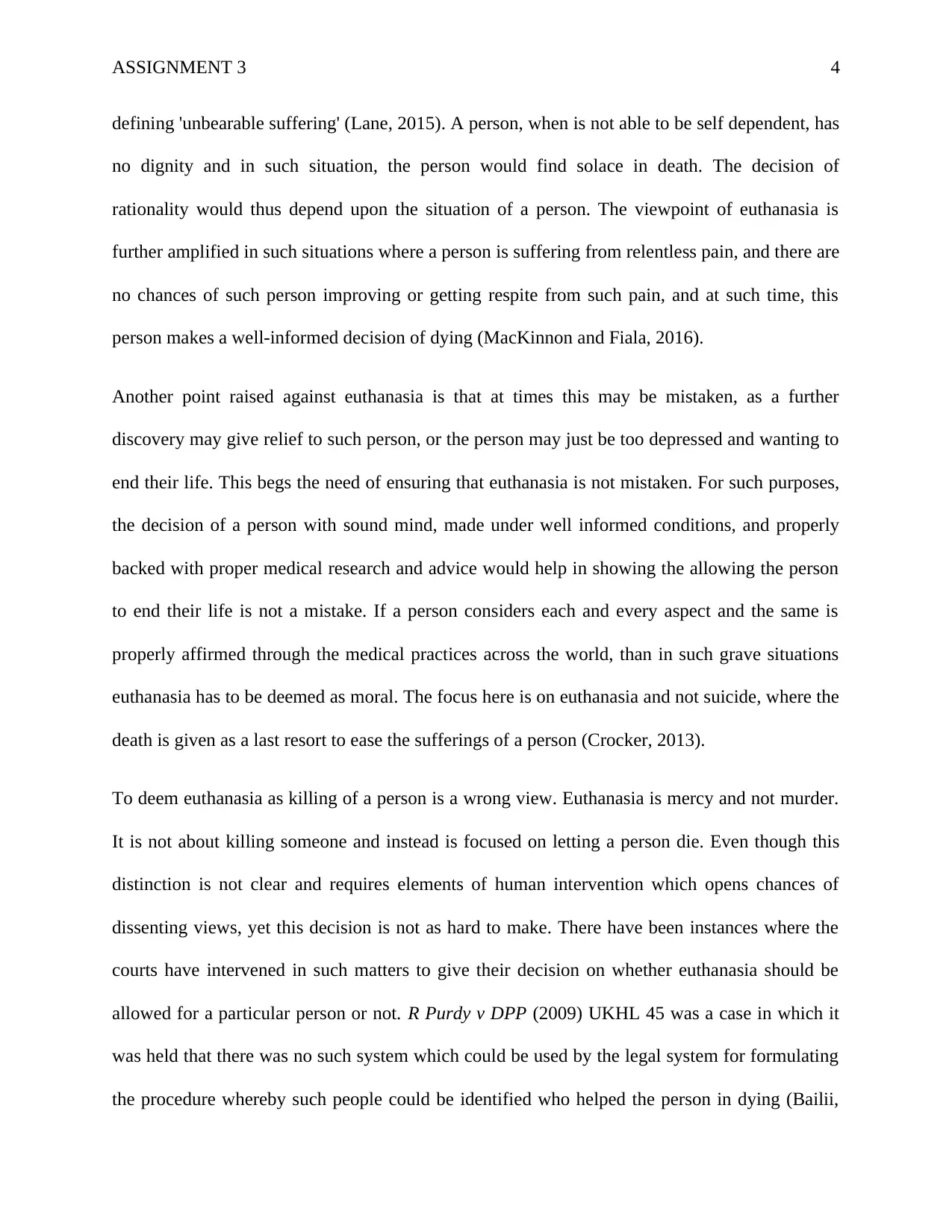
ASSIGNMENT 3 4
defining 'unbearable suffering' (Lane, 2015). A person, when is not able to be self dependent, has
no dignity and in such situation, the person would find solace in death. The decision of
rationality would thus depend upon the situation of a person. The viewpoint of euthanasia is
further amplified in such situations where a person is suffering from relentless pain, and there are
no chances of such person improving or getting respite from such pain, and at such time, this
person makes a well-informed decision of dying (MacKinnon and Fiala, 2016).
Another point raised against euthanasia is that at times this may be mistaken, as a further
discovery may give relief to such person, or the person may just be too depressed and wanting to
end their life. This begs the need of ensuring that euthanasia is not mistaken. For such purposes,
the decision of a person with sound mind, made under well informed conditions, and properly
backed with proper medical research and advice would help in showing the allowing the person
to end their life is not a mistake. If a person considers each and every aspect and the same is
properly affirmed through the medical practices across the world, than in such grave situations
euthanasia has to be deemed as moral. The focus here is on euthanasia and not suicide, where the
death is given as a last resort to ease the sufferings of a person (Crocker, 2013).
To deem euthanasia as killing of a person is a wrong view. Euthanasia is mercy and not murder.
It is not about killing someone and instead is focused on letting a person die. Even though this
distinction is not clear and requires elements of human intervention which opens chances of
dissenting views, yet this decision is not as hard to make. There have been instances where the
courts have intervened in such matters to give their decision on whether euthanasia should be
allowed for a particular person or not. R Purdy v DPP (2009) UKHL 45 was a case in which it
was held that there was no such system which could be used by the legal system for formulating
the procedure whereby such people could be identified who helped the person in dying (Bailii,
defining 'unbearable suffering' (Lane, 2015). A person, when is not able to be self dependent, has
no dignity and in such situation, the person would find solace in death. The decision of
rationality would thus depend upon the situation of a person. The viewpoint of euthanasia is
further amplified in such situations where a person is suffering from relentless pain, and there are
no chances of such person improving or getting respite from such pain, and at such time, this
person makes a well-informed decision of dying (MacKinnon and Fiala, 2016).
Another point raised against euthanasia is that at times this may be mistaken, as a further
discovery may give relief to such person, or the person may just be too depressed and wanting to
end their life. This begs the need of ensuring that euthanasia is not mistaken. For such purposes,
the decision of a person with sound mind, made under well informed conditions, and properly
backed with proper medical research and advice would help in showing the allowing the person
to end their life is not a mistake. If a person considers each and every aspect and the same is
properly affirmed through the medical practices across the world, than in such grave situations
euthanasia has to be deemed as moral. The focus here is on euthanasia and not suicide, where the
death is given as a last resort to ease the sufferings of a person (Crocker, 2013).
To deem euthanasia as killing of a person is a wrong view. Euthanasia is mercy and not murder.
It is not about killing someone and instead is focused on letting a person die. Even though this
distinction is not clear and requires elements of human intervention which opens chances of
dissenting views, yet this decision is not as hard to make. There have been instances where the
courts have intervened in such matters to give their decision on whether euthanasia should be
allowed for a particular person or not. R Purdy v DPP (2009) UKHL 45 was a case in which it
was held that there was no such system which could be used by the legal system for formulating
the procedure whereby such people could be identified who helped the person in dying (Bailii,
Paraphrase This Document
Need a fresh take? Get an instant paraphrase of this document with our AI Paraphraser
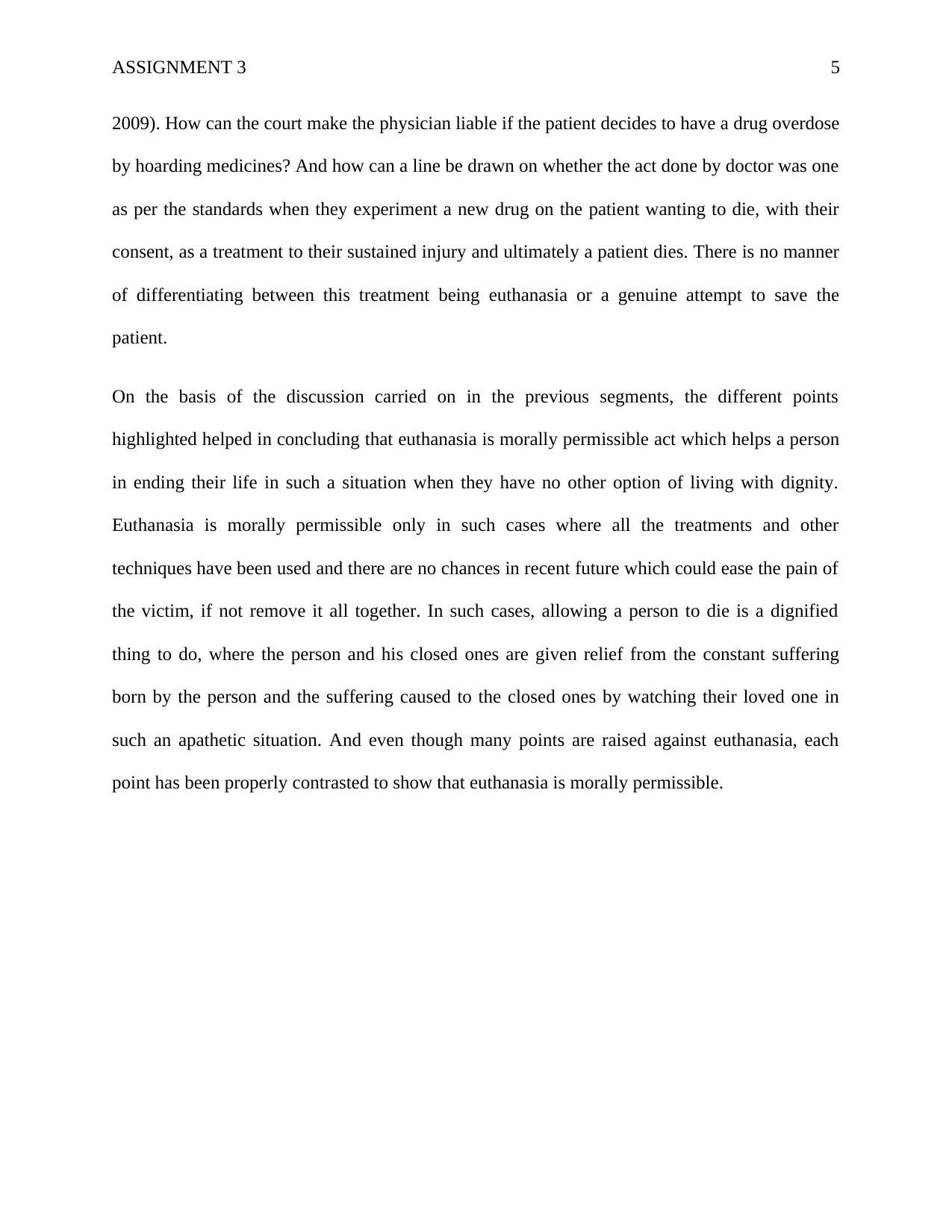
ASSIGNMENT 3 5
2009). How can the court make the physician liable if the patient decides to have a drug overdose
by hoarding medicines? And how can a line be drawn on whether the act done by doctor was one
as per the standards when they experiment a new drug on the patient wanting to die, with their
consent, as a treatment to their sustained injury and ultimately a patient dies. There is no manner
of differentiating between this treatment being euthanasia or a genuine attempt to save the
patient.
On the basis of the discussion carried on in the previous segments, the different points
highlighted helped in concluding that euthanasia is morally permissible act which helps a person
in ending their life in such a situation when they have no other option of living with dignity.
Euthanasia is morally permissible only in such cases where all the treatments and other
techniques have been used and there are no chances in recent future which could ease the pain of
the victim, if not remove it all together. In such cases, allowing a person to die is a dignified
thing to do, where the person and his closed ones are given relief from the constant suffering
born by the person and the suffering caused to the closed ones by watching their loved one in
such an apathetic situation. And even though many points are raised against euthanasia, each
point has been properly contrasted to show that euthanasia is morally permissible.
2009). How can the court make the physician liable if the patient decides to have a drug overdose
by hoarding medicines? And how can a line be drawn on whether the act done by doctor was one
as per the standards when they experiment a new drug on the patient wanting to die, with their
consent, as a treatment to their sustained injury and ultimately a patient dies. There is no manner
of differentiating between this treatment being euthanasia or a genuine attempt to save the
patient.
On the basis of the discussion carried on in the previous segments, the different points
highlighted helped in concluding that euthanasia is morally permissible act which helps a person
in ending their life in such a situation when they have no other option of living with dignity.
Euthanasia is morally permissible only in such cases where all the treatments and other
techniques have been used and there are no chances in recent future which could ease the pain of
the victim, if not remove it all together. In such cases, allowing a person to die is a dignified
thing to do, where the person and his closed ones are given relief from the constant suffering
born by the person and the suffering caused to the closed ones by watching their loved one in
such an apathetic situation. And even though many points are raised against euthanasia, each
point has been properly contrasted to show that euthanasia is morally permissible.
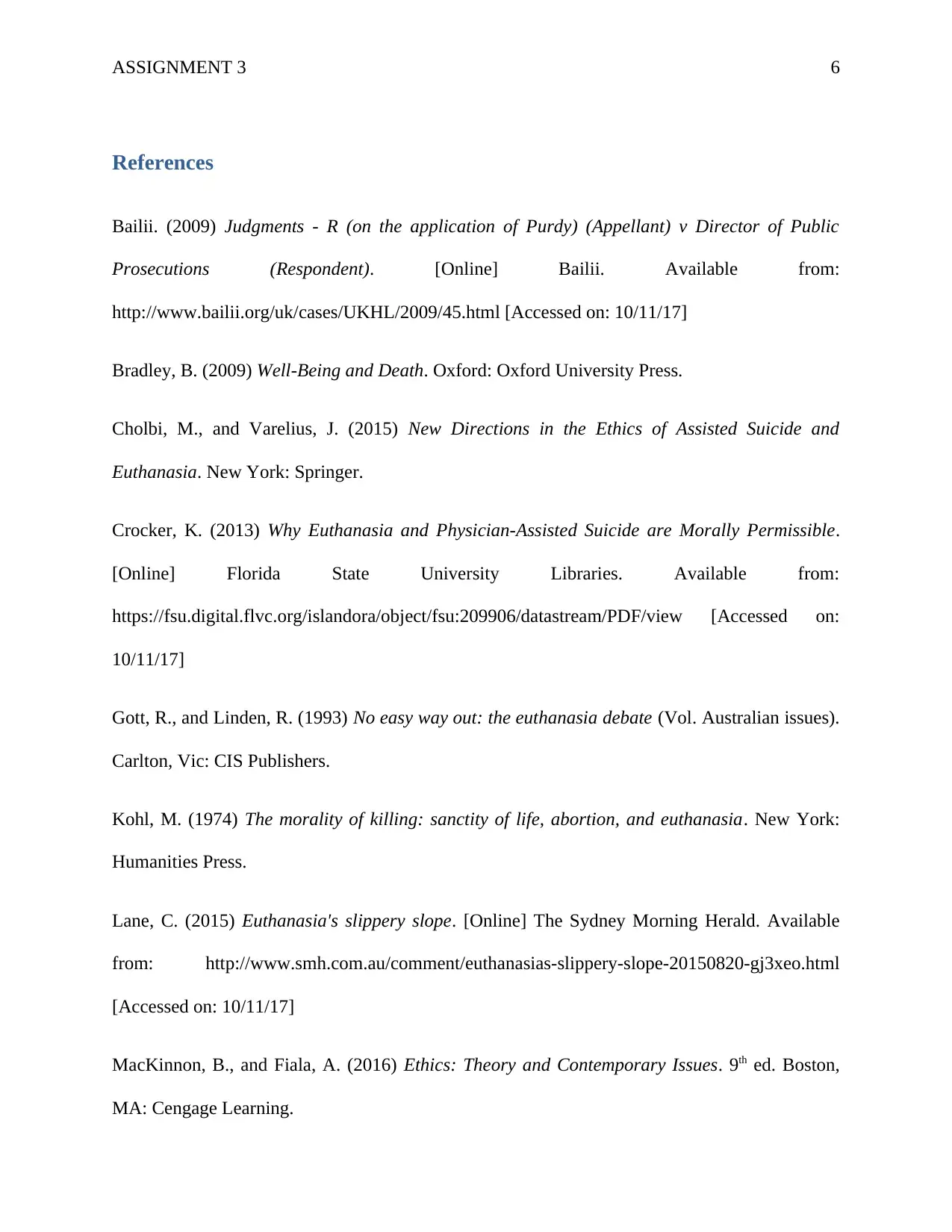
ASSIGNMENT 3 6
References
Bailii. (2009) Judgments - R (on the application of Purdy) (Appellant) v Director of Public
Prosecutions (Respondent). [Online] Bailii. Available from:
http://www.bailii.org/uk/cases/UKHL/2009/45.html [Accessed on: 10/11/17]
Bradley, B. (2009) Well-Being and Death. Oxford: Oxford University Press.
Cholbi, M., and Varelius, J. (2015) New Directions in the Ethics of Assisted Suicide and
Euthanasia. New York: Springer.
Crocker, K. (2013) Why Euthanasia and Physician-Assisted Suicide are Morally Permissible.
[Online] Florida State University Libraries. Available from:
https://fsu.digital.flvc.org/islandora/object/fsu:209906/datastream/PDF/view [Accessed on:
10/11/17]
Gott, R., and Linden, R. (1993) No easy way out: the euthanasia debate (Vol. Australian issues).
Carlton, Vic: CIS Publishers.
Kohl, M. (1974) The morality of killing: sanctity of life, abortion, and euthanasia. New York:
Humanities Press.
Lane, C. (2015) Euthanasia's slippery slope. [Online] The Sydney Morning Herald. Available
from: http://www.smh.com.au/comment/euthanasias-slippery-slope-20150820-gj3xeo.html
[Accessed on: 10/11/17]
MacKinnon, B., and Fiala, A. (2016) Ethics: Theory and Contemporary Issues. 9th ed. Boston,
MA: Cengage Learning.
References
Bailii. (2009) Judgments - R (on the application of Purdy) (Appellant) v Director of Public
Prosecutions (Respondent). [Online] Bailii. Available from:
http://www.bailii.org/uk/cases/UKHL/2009/45.html [Accessed on: 10/11/17]
Bradley, B. (2009) Well-Being and Death. Oxford: Oxford University Press.
Cholbi, M., and Varelius, J. (2015) New Directions in the Ethics of Assisted Suicide and
Euthanasia. New York: Springer.
Crocker, K. (2013) Why Euthanasia and Physician-Assisted Suicide are Morally Permissible.
[Online] Florida State University Libraries. Available from:
https://fsu.digital.flvc.org/islandora/object/fsu:209906/datastream/PDF/view [Accessed on:
10/11/17]
Gott, R., and Linden, R. (1993) No easy way out: the euthanasia debate (Vol. Australian issues).
Carlton, Vic: CIS Publishers.
Kohl, M. (1974) The morality of killing: sanctity of life, abortion, and euthanasia. New York:
Humanities Press.
Lane, C. (2015) Euthanasia's slippery slope. [Online] The Sydney Morning Herald. Available
from: http://www.smh.com.au/comment/euthanasias-slippery-slope-20150820-gj3xeo.html
[Accessed on: 10/11/17]
MacKinnon, B., and Fiala, A. (2016) Ethics: Theory and Contemporary Issues. 9th ed. Boston,
MA: Cengage Learning.
⊘ This is a preview!⊘
Do you want full access?
Subscribe today to unlock all pages.

Trusted by 1+ million students worldwide
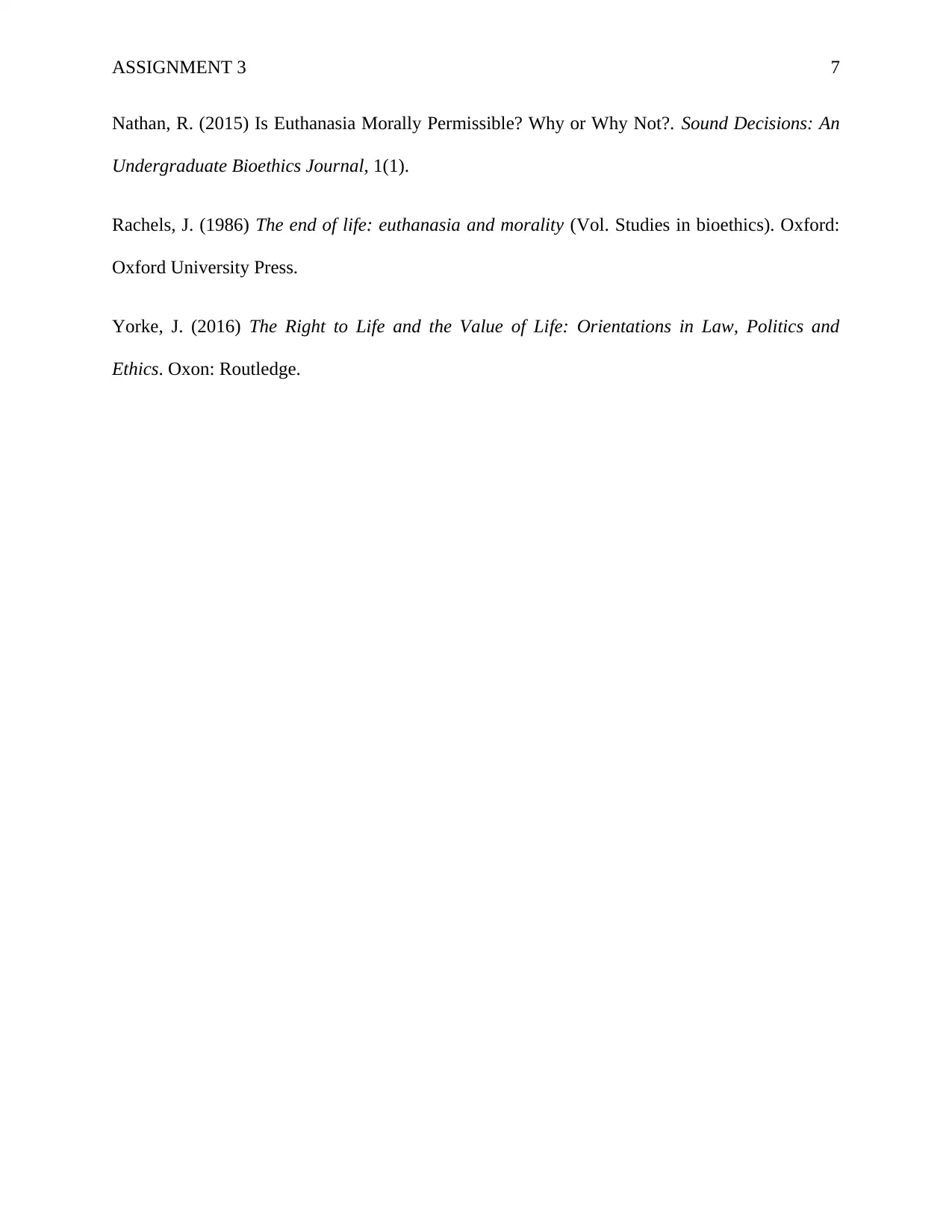
ASSIGNMENT 3 7
Nathan, R. (2015) Is Euthanasia Morally Permissible? Why or Why Not?. Sound Decisions: An
Undergraduate Bioethics Journal, 1(1).
Rachels, J. (1986) The end of life: euthanasia and morality (Vol. Studies in bioethics). Oxford:
Oxford University Press.
Yorke, J. (2016) The Right to Life and the Value of Life: Orientations in Law, Politics and
Ethics. Oxon: Routledge.
Nathan, R. (2015) Is Euthanasia Morally Permissible? Why or Why Not?. Sound Decisions: An
Undergraduate Bioethics Journal, 1(1).
Rachels, J. (1986) The end of life: euthanasia and morality (Vol. Studies in bioethics). Oxford:
Oxford University Press.
Yorke, J. (2016) The Right to Life and the Value of Life: Orientations in Law, Politics and
Ethics. Oxon: Routledge.
1 out of 7